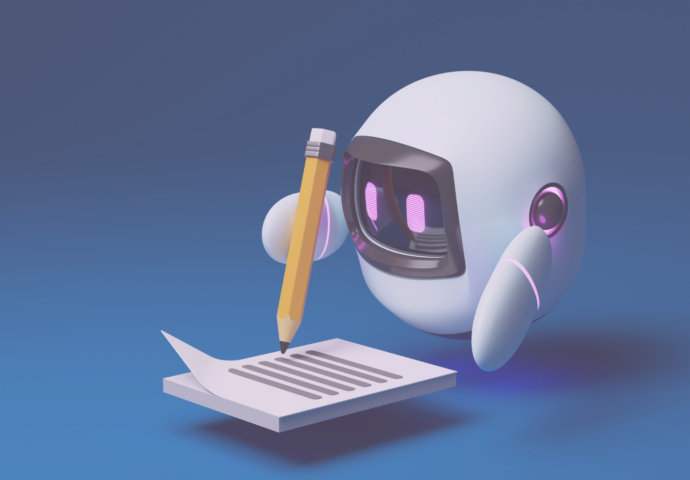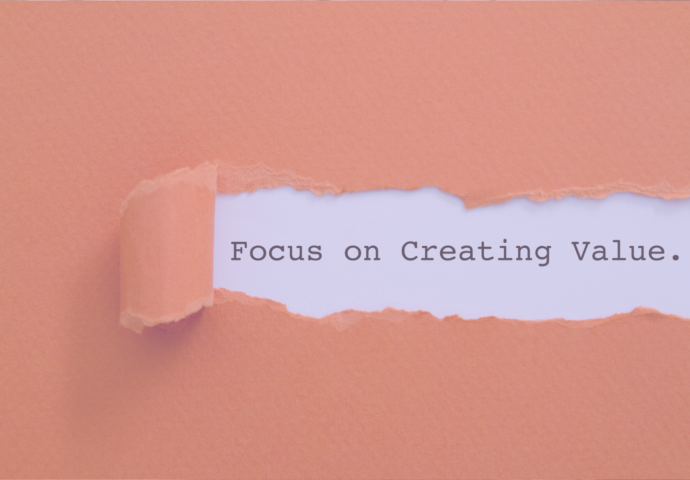A Real Example of Using AI in My Work

ChatGPT.
Language-Learning Models.
Artificial Intelligence.
If you’re a content person, a marketing professional, or really anyone on the internet these days… you’ve been hearing a lot about AI.
Even if you aren’t seeking out content about AI content, it’s hard to avoid the headlines:
- “75 AI tools you need to know about RIGHT NOW” (why don’t you just tell me 3?)
- “AI poses risk of Extinction, industry leaders warn” (cool cool cool)
- “Chat GPT may be coming for these jobs” (shuts eyes, puts hands over ears, and sings 🎶 la la la 🎶)
Did I panic when I first saw what ChatGPT could do? OF COURSE I DID.
But now, things have settled down a bit and I’ve become more AI-curious than AI-terrified.
Which led me to consider how I could more intentionally try incorporating these tools in my client work. (which led to this post…)
First, a quick overview of the project:
A long-time client had recorded videos with industry experts at a conference earlier this year. These interviews were educational in nature where folks shared their knowledge and advice about topics important to my client’s target audience. I was tasked with turning these videos into a series of blog posts that pulled together quotes and clips into an educational series.
I’d done a similar project for my client in 2022, so I was interested to tackle this work again with a few new tools at my disposal.
For this project, I used:
Descript – an audio editing tool I’ve discovered through podcast editing (and highly recommend). It does some of the better talk-to-text transcripts I’ve seen, and it can pull in audio directly from the computer, even if your speaker is on mute. I currently use the free version.
ChatGPT 4 – the AI tool (though is it really AI?) that first took the world by storm. I use the non-pro/unpaid version, though I am thinking about trying ChatGPT Pro.
And my process went something like this:
- I watched all the full interviews through (roughly a dozen people with 5-10 minute clips) and thought about how to group the videos into topics/themes.
- After working with a video editor to clip out the content I wanted to use, I ran the clips through Descript to create transcripts, grouping by topic
- I would then pull each transcript into ChatGPT and ask it to pull out the most interesting quotes.
- I would do this for each clip in the topic group and then ask ChatGPT to write a blog post that incorporated these quotes.
And here’s what I found helpful about using Descript:
- The transcripts were good enough for me AND ChatGPT to parse what was going on.
- It was valuable to have the transcript alongside the recorded audio so I could go in and listen to the quote, make sure it was accurate, and see if there was anything before or after I wanted to incorporate.
- When the audio was distorted in a video with an annoying hum over it, Descript was able to pull the transcript without me needing to listen to the loud/irritating sound over and over again to pull out useful bits.
And here’s where this tool fell short:
- Accents seem to be a struggle. One interviewee had a strong Southern accent, and I had to go back in to translate more of his quotes.
- Pauses and punctuation is a bit haphazard. Over time, I hope these transcript tools will get better at processing “normal,” unrehearsed speech and understand where people are continuing their thoughts.
And here’s what I found helpful about using ChatGPT:
- While I didn’t necessarily find every quote ChatGPT pulled to be “interesting” it was helpful to have an easily skimable list and to think about how I might pull these quotes in
- Seeing what ChatGPT thinks should be covered in a particular post sometimes reminded me of a point I should include.
- I am frequently impressed with ChatGPTs headline writing. If I thought my magic was in my headline creation, maybe I’d be upset by this, but as a longer-form writer, I love having this tool to take on the pithy work for me.
And here’s where ChatGPT REALLY fell short and why I’m feeling very comfortable about my continued employment as a writer…
The blog posts were bad.
I don’t mean poorly written or even inaccurate (though I didn’t thoroughly fact-check after I realized how useless they were for my purposes).
Someone could post these generated articles verbatim, and I think they’d perform fine.
But they lacked the context I had from years of working with and knowing this client – and their audience. This client works with some very specific groups of people that they (and I alongside of them) know incredibly well.
The blog posts ChatGPT wrote failed to:
- Go deep enough on any of the topics I’d identified to focus on
- Include concepts I knew were most important to the readers
- Provide enough context around the quotes and expert information
- Use the language our readers were familiar with (instead of jargon)
- Capture the feelings/emotions/experience of the people we wanted to connect with
And this is true even after I gave ChatGPT follow-up prompts to focus in on a particular topic and to pull in information from other sources.
The posts got better. But they were still so far from what I needed, I was better off writing them myself.
Posting GPT’s content alongside the other articles I’d written and tailored to these groups wouldn’t live up to the value we’re trying to provide. It just doesn’t achieve the standards we set for ourselves.
My takeaway?
I’ll keep using and experimenting with these tools. They made the process this time around a lot more efficient, and this Econ major LOVES efficiency.
But they don’t have the human touch. So for now… I’m going to leave the writing to me.










